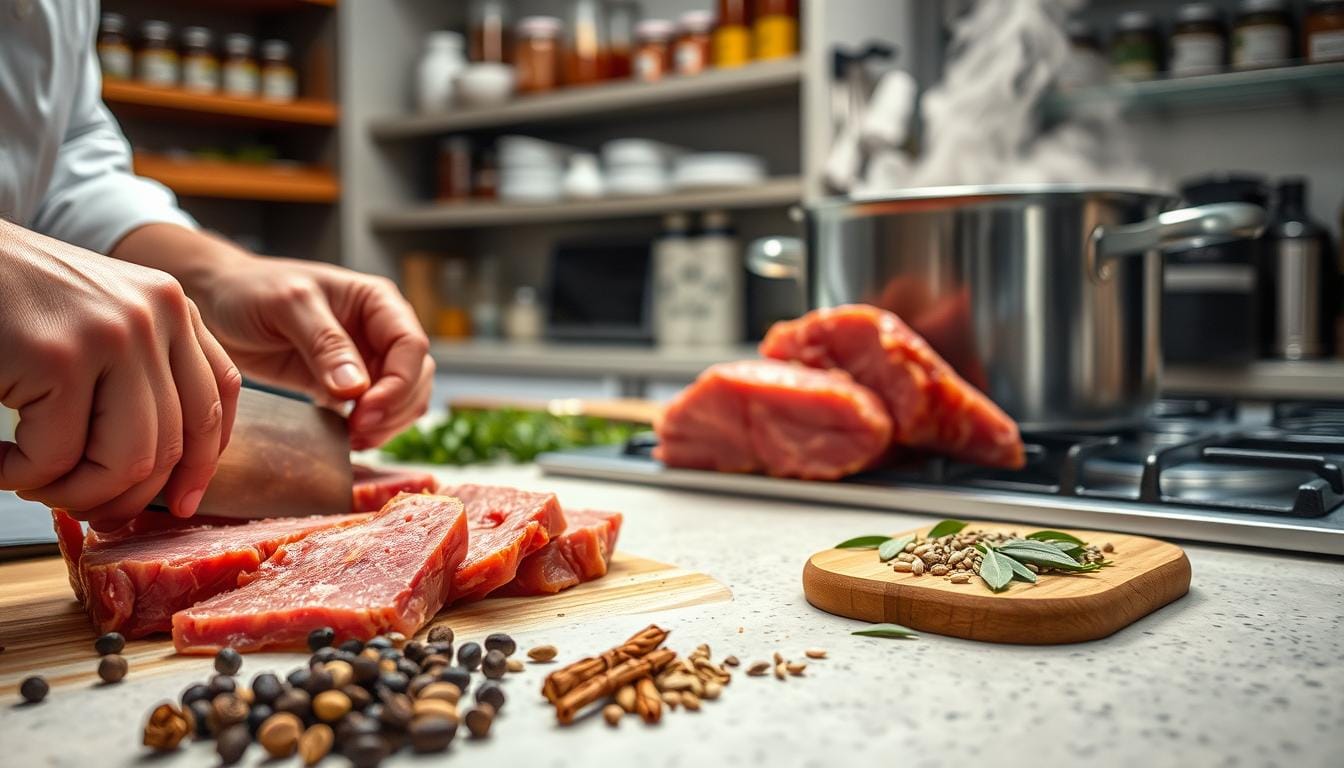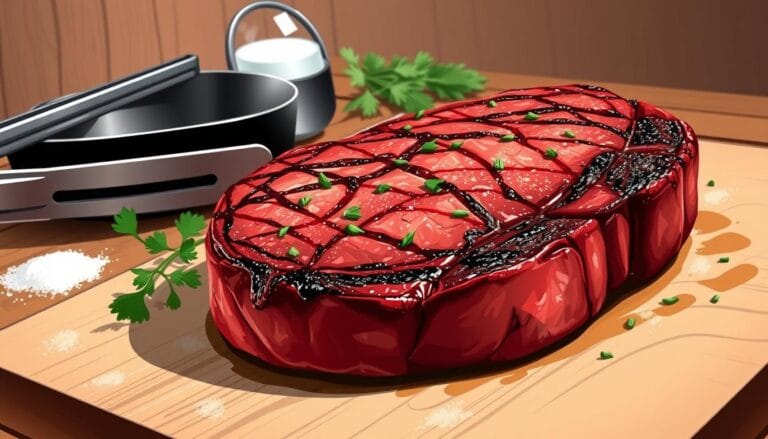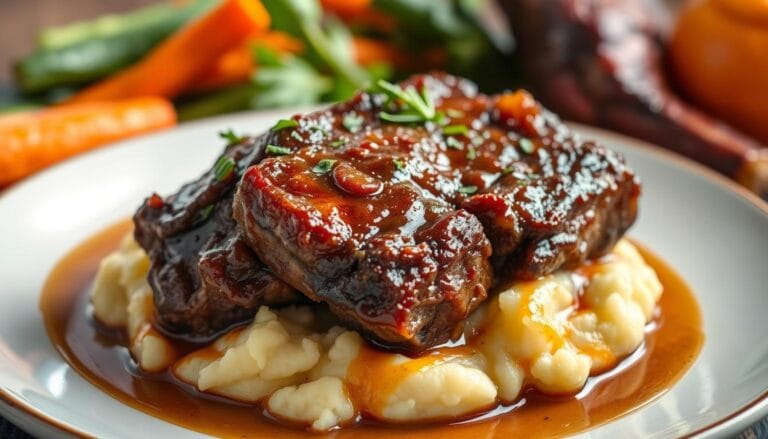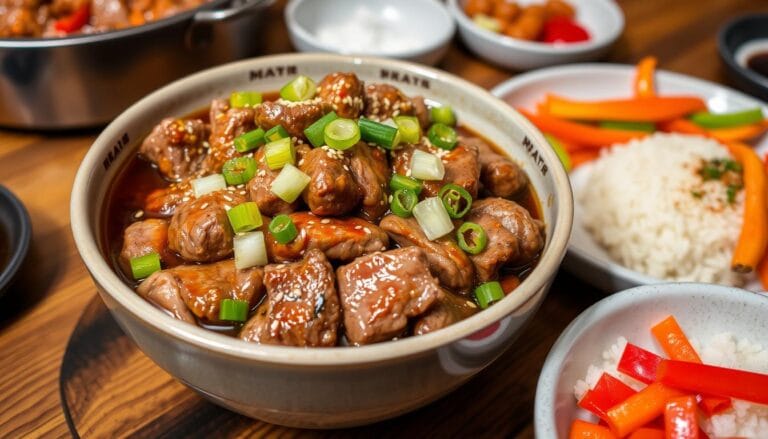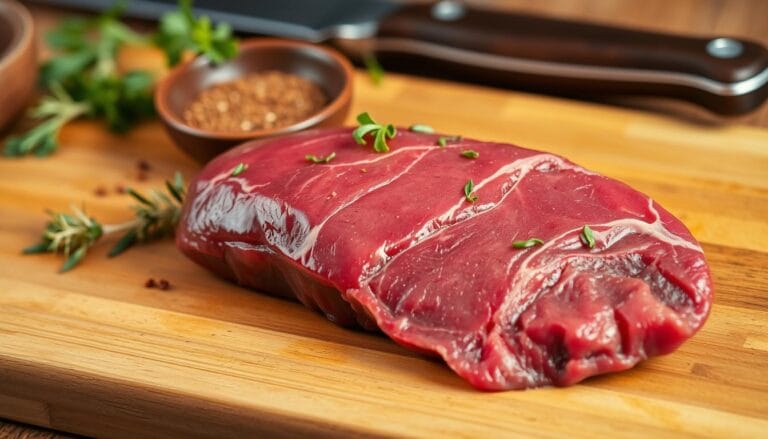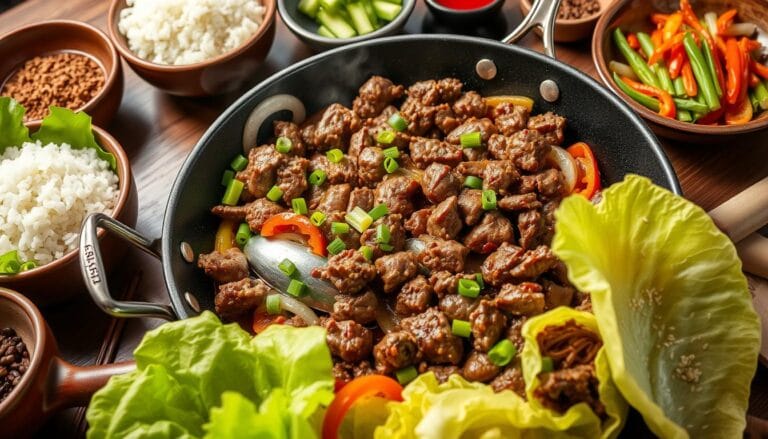How Is Corned Beef Made? A Simple Explanation
Watching my grandmother make corned beef was amazing. She turned a simple beef brisket into a masterpiece. Her kitchen was filled with spices, creating a feast for the senses.
Learning about corned beef reveals a rich tradition. It combines old preservation methods with tasty flavors. Your corned beef recipe connects you to a deep cultural heritage.
Corned beef starts with a 5-pound beef brisket. It’s chosen for its texture and flavor. The magic happens during a 5 to 7 day curing process, where the meat is transformed through brining.
Imagine taking a cheap cut of beef and making it delicious. This is the art of corned beef. It turns tough meat into tender, flavorful food loved by many.
Making corned beef is both a science and an art. It needs patience, detail, and a love for traditional cooking. Whether for St. Patrick’s Day or a hearty meal, mastering the recipe connects you to culinary traditions passed down through generations.
Table of Contents
Understanding What Corned Beef Is
Corned beef is a tasty tradition that turns tough beef into a delicious treat. The curing process has a long history. It makes ordinary meat into a flavorful dish loved by many for years.
The Origin of the Name “Corned”
The name “corned” might seem odd, but it’s easy to understand. Corn here means the big salt grains used to cure meat. These salt grains, like corn, helped specially preserve the beef.
Key Components of Traditional Corned Beef
- Beef brisket (primary cut used)
- Coarse salt for curing
- Nitrites for color preservation
- Spices and seasonings
When making homemade corned beef, start with the right meat. The brisket is chosen for its rich taste and texture. It’s the perfect meat for curing.
The Role of Brisket in Corned Beef
Brisket is key to making real corned beef. It comes from the cow’s lower chest, with tough fibers that soften with slow cooking and curing. The flat cut of brisket is best for homemade corned beef. It’s leaner and easier to slice.
| Brisket Cut | Characteristics | Suitability for Corned Beef |
|---|---|---|
| Flat Cut | Leaner, easier to slice | Excellent for traditional recipes |
| Point Cut | Fattier, more flavorful | Richer taste, less uniform slicing |
Learning about the corned beef curing process shows us the beauty of this tradition. It has traveled from Ireland to American dinner tables.
The Essential Ingredients for Corned Beef
To make traditional corned beef, you need a special mix of ingredients. This mix turns a regular beef brisket into a tasty treat. The key is a salt brine that adds deep, rich flavors.
The ingredients for the corned beef brine are very important. You’ll need:
- 9 ounces of pickling salt or coarse salt
- ½ cup of granulated sugar
- 4 minced garlic cloves
- 1 gallon of water
Spices are also crucial for making traditional corned beef. The classic mix includes:
- Bay leaves for a nice aroma
- Whole peppercorns for a bit of heat
- Mustard seeds for a tangy taste
- Juniper berries for a pine-like flavor
- Coriander seeds for citrusy notes
- Whole cloves for a warm, spicy taste
When making your brine, remember to add 2 tablespoons of pickling spices. This can really boost the flavor of your corned beef. The brining time is usually 5 to 10 days, but 7 days is best for the perfect taste and texture.
Choosing the right meat is also key. A 5-pound flat-cut beef brisket is the best choice for traditional corned beef. It ensures your corned beef is tender and full of flavor.
The Science Behind the Pink Color
The pink color of corned beef is more than just a look. It’s a result of a scientific curing process. This process turns regular beef into the tasty corned beef we love.
Sodium nitrite is key in making corned beef. It adds color and helps keep meat fresh. Let’s look into how it works.
Understanding Nitrites and Their Function
Nitrites do a lot in meat preservation:
- They create the pink color
- They stop bacteria from growing
- They help keep flavors in
- They prevent meat from spoiling
Historical Use of Saltpeter
Before today’s methods, potassium nitrite (saltpeter) was used. It was also in gunpowder, showing its many uses.
Modern Curing Methods
Now, making corned beef is different. We use “pink salt” or curing salt. It has sodium nitrite and is pink to tell it apart from regular salt. This helps control the curing and keeps food safe.
Learning how corned beef is made shows the science behind it. It turns a simple brisket into a tasty, preserved dish through chemistry.
How Is Corned Beef Made: The Step-by-Step Process
Learning to make corned beef at home is a fun journey. It turns a simple beef brisket into a tasty treat. Cooking it requires patience and careful attention.
First, prepare the brine solution. You’ll need:
- 1 gallon of water
- 2 cups of kosher salt
- ½ cup of sugar
- Pickling spices (including peppercorns, mustard seeds, and coriander)
The curing process is key. Place a 5-pound brisket in the cooled brine. Refrigerate it for 5-7 days to cure evenly.
After curing, rinse the beef well to remove excess salt. This keeps your corned beef from being too salty. Then, dry the meat and get ready to cook.
There are different ways to cook it, but a classic method is:
- Put the brisket in a 6-quart Dutch oven
- Add 2 cups of beef stock
- Simmer for about 3 hours
- Add veggies like cabbage and carrots
This method makes a tender, flavorful corned beef. It serves 8 people and has about 500 calories per serving. Learning this will wow your friends and family!
The Curing Process and Brine Solution
The corned beef curing process turns regular beef into a tasty treat. Knowing how to make the perfect brine solution can make your homemade corned beef truly special.
The brine is key when making corned beef. It’s a salt solution that adds amazing flavor and keeps the meat tender.
Creating the Perfect Brine Mixture
Your brine needs a mix of ingredients for great taste and preservation. Here’s what you should include:
- Kosher salt (better than table salt)
- Brown sugar for sweetness
- Pickling spices (2 tablespoons per batch)
- Sodium nitrite for color and preservation
Optimal Curing Time and Temperature
Curing corned beef takes time and care. Here’s what you need to do:
| Curing Parameter | Recommended Specification |
|---|---|
| Curing Time | 7-10 days in the fridge |
| Brine Temperature | 35-40°F (like the fridge) |
| Brine Quantity | Enough to cover a 3-4 pound brisket |
While curing, the meat soaks up salt, spices, and nitrites. These give it a pink color and rich taste. Patience is key – don’t rush it, or your corned beef might not taste as good.
Traditional Spices and Seasonings Used
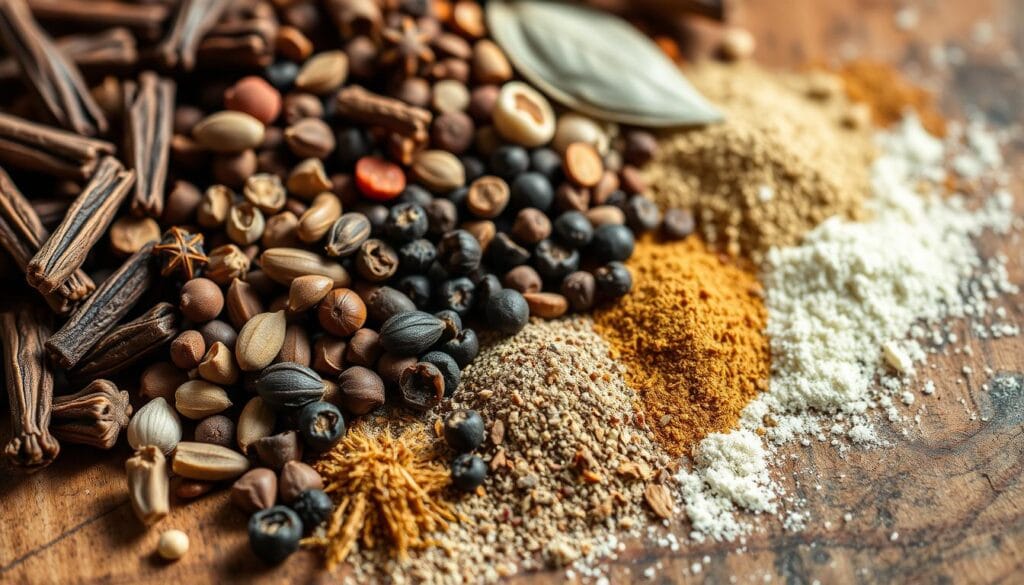
To make a real corned beef recipe, you need the right mix of spices. These spices turn a simple cut of meat into a dish full of flavor. The traditional way of making corned beef uses special seasonings that make the meat taste unique.
Your own corned beef seasoning mix has 9 key ingredients. These ingredients work together to create a deep, complex flavor. Here’s what each spice does:
- Black Peppercorns: Adds sharp, warming heat
- Mustard Seeds: Provides tangy, slightly bitter notes
- Coriander Seeds: Introduces a citrusy, nutty undertone
- Red Pepper Flakes: Brings a subtle spicy kick
- Whole Cloves: Delivers a deep, warming flavor
- Bay Leaves: Contributes an earthy, herbal essence
- Juniper Berries: Offers a piney, slightly gin-like taste
Want to make your corned beef recipe your own? Here are some tips:
- Preparing the seasoning mix takes just 5 minutes
- The recipe makes 8 tablespoons of seasoning
- Use 4 tablespoons for homemade corned beef
- Keep the mix in an airtight container for up to 6 months
Try adding spices like star anise or allspice to your corned beef. It will give your dish a special flavor that will wow your guests.
Cooking Methods and Techniques
Cooking corned beef at home can seem tough, but it’s easy with the right techniques. The best way to make corned beef is to pick the right cooking method. This ensures the meat is tender and full of flavor.
There are several ways to cook corned beef, turning it into a delicious meal. Each method has its own benefits for getting the perfect texture and taste.
Boiling: The Traditional Approach
Boiling is the classic way to cook corned beef. Here’s what you need to know:
- Traditionally boil for 3 to 4 hours
- Use a large pot with enough water to fully submerge the meat
- Add vegetables like potatoes and cabbage 30 minutes before finishing
Slow Cooking: A Convenient Alternative
Slow cookers make cooking corned beef easy:
- Cook on high for approximately 4.5 hours
- Low setting requires 8 to 9 hours
- Perfect for hands-off cooking
Temperature and Timing Guidelines
To get perfect corned beef, pay attention to temperature and timing. The meat should reach 145 degrees Fahrenheit. For oven cooking, use 400°F for about 50 minutes per pound until it’s 170°F inside.
Pro tip: Let the meat rest for 30 minutes after cooking. This makes it tender and flavorful.
The Difference Between Corned Beef and Pastrami
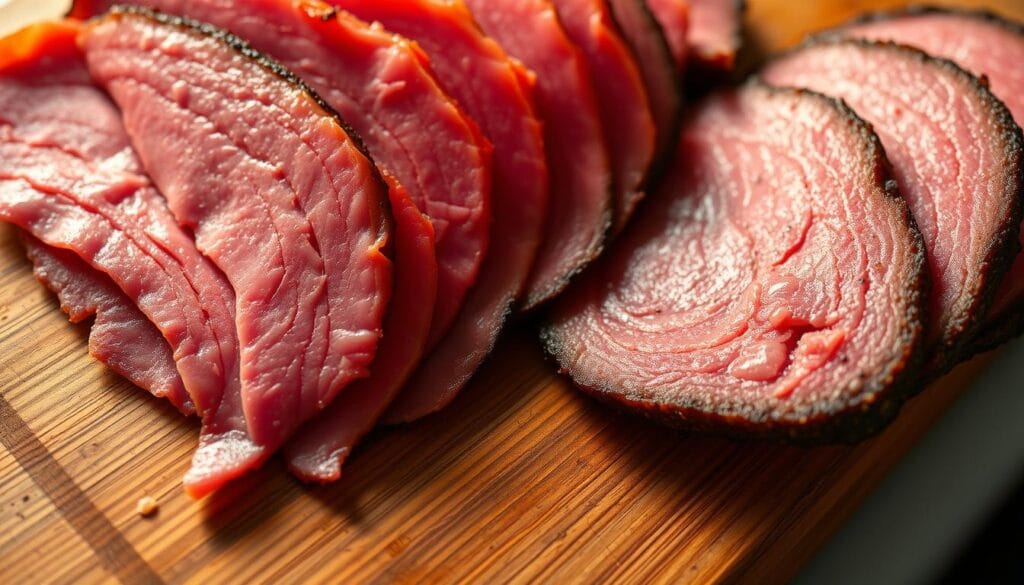
Exploring how corned beef is made reveals its unique differences from pastrami. Both are tasty cured meats, but they come from different places and are made in different ways.
Pastrami and corned beef may look alike, but they have different histories. Pastrami comes from Romania, made from the navel end of beef brisket. Corned beef, on the other hand, has Irish-American roots and is made from a leaner brisket cut.
- Corned beef uses the flat, leaner cut of brisket
- Pastrami uses the fattier navel end with more marbling
- Cooking methods differ significantly
The corned beef recipe involves brining and boiling. Pastrami, however, goes through brining, smoking, and steaming. This makes their flavors and textures very different.
| Characteristic | Corned Beef | Pastrami |
|---|---|---|
| Origin | Ireland/America | Romania |
| Meat Cut | Lean Brisket Flat | Fatty Brisket Navel |
| Preparation | Brined, Boiled | Brined, Smoked, Steamed |
| Typical Use | St. Patrick’s Day Dishes | Deli Sandwiches |
Knowing these differences helps you enjoy each meat’s special qualities. Whether you’re making a corned beef recipe or trying deli classics, it’s all about the unique flavors and textures.
The Irish-American Connection
The story of corned beef in America is tied to Irish immigrants. When Irish families came to the United States in the 19th century, they found a new world. Corned beef became a sign of hope and change for them.
In Ireland, beef was for kings, and pork was more common. The Great Potato Famine sent over a million Irish to America. There, they found beef was cheap. New York’s Irish and Jewish areas started the tradition of homemade corned beef.
Kosher butchers helped make corned beef popular among Irish Americans. The brisket cut made beef affordable. By the early 1900s, corned beef was a big part of Irish-American life, especially on St. Patrick’s Day.
Now, corned beef is more than food. It shows the strength and creativity of Irish immigrants. They turned hard times into a beloved tradition that many Americans enjoy today.

